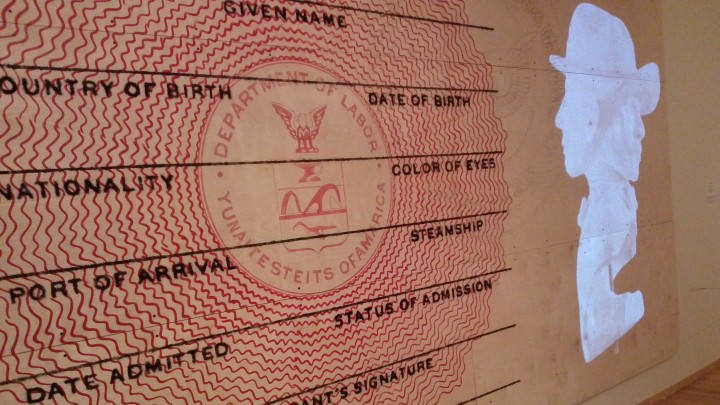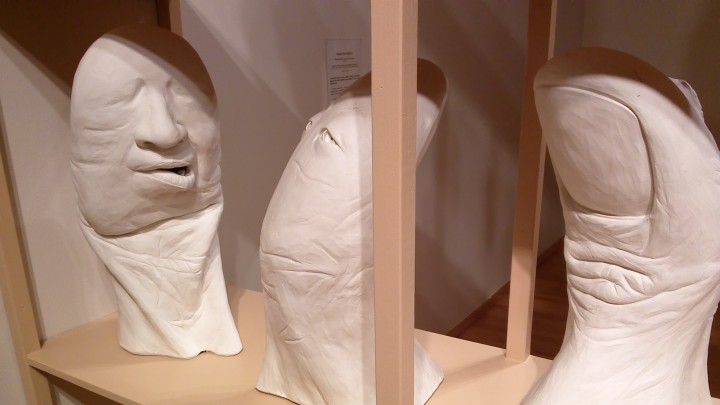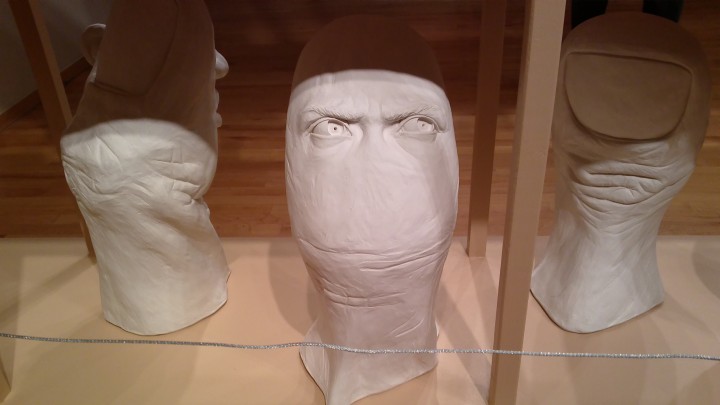The latest exhibition to open at the National Museum of Mexican Art is Deportable Aliens, which features new multimedia and sculpture work by Rodrigo Lara Zendejas. The exhibit, which runs through February 28 of next year, is the first installment of a six-part series, Latino Americans: 500 Years of History.
In these new works, Lara revisits the oft-forgotten history of Mexican Repatriation, the mass deportation of upwards of two million people from the United States during the Great Depression. This forced relocation of legal residents or U.S. citizens of Mexican descent between ~1929-39 was a policy conceived from a collision of high unemployment and poverty with anti-immigrant panic and a legacy of racism against people of Mexican heritage. Lara’s work gives us a glimpse at this important historical event, centering on themes of identification, documentation and dehumanization.
Though occupying the smallest gallery space at the museum, Lara’s exhibit does not lack in its power, irony and ability to connect history to modern-day immigration processes and experiences.
 Taking up the entirety of the Kraft Gallery’s left wall is a large wooden reproduction of a 1930s-era identification card, with a head of a person projected where an ID photo would be. This bright and translucent bust has two faces smiling bizarrely on the front and back of the head, which rotates and changes directions erratically. When you walk up to this giant ID card, you will notice the texture of the writing is frizzy and dark brown. In fact, the entire card is ‘written’ in the hair particles of the artist. Looking at it, I couldn’t help but think that, in real life, the lines of a pen would write on an ID card to categorize and define a person. Here, the hair, a part of the body and a remnant of identity, which the artist collected for two years, is used or perhaps sacrificed in creating an overwhelming representation of a legal document.
Taking up the entirety of the Kraft Gallery’s left wall is a large wooden reproduction of a 1930s-era identification card, with a head of a person projected where an ID photo would be. This bright and translucent bust has two faces smiling bizarrely on the front and back of the head, which rotates and changes directions erratically. When you walk up to this giant ID card, you will notice the texture of the writing is frizzy and dark brown. In fact, the entire card is ‘written’ in the hair particles of the artist. Looking at it, I couldn’t help but think that, in real life, the lines of a pen would write on an ID card to categorize and define a person. Here, the hair, a part of the body and a remnant of identity, which the artist collected for two years, is used or perhaps sacrificed in creating an overwhelming representation of a legal document.
 Across from this piece is a plain wooden shelf of several porcelain statues that appear to be in the shape of thumbs with distorted and exaggerated parts of human faces, many of them also smiling; this one has only eyes, some have ears and others don’t, this one has a mouth and a mustache but no eyes or ears. These aren’t statues of whole people, whole bodies or even of whole faces; they are thumbprints, only distorted traces of a whole person that the state could use to identify, categorize and catalog them. Though these are partial bodies, Lara creates monuments of them.
Across from this piece is a plain wooden shelf of several porcelain statues that appear to be in the shape of thumbs with distorted and exaggerated parts of human faces, many of them also smiling; this one has only eyes, some have ears and others don’t, this one has a mouth and a mustache but no eyes or ears. These aren’t statues of whole people, whole bodies or even of whole faces; they are thumbprints, only distorted traces of a whole person that the state could use to identify, categorize and catalog them. Though these are partial bodies, Lara creates monuments of them. In Lara’s pieces the identities are not so much identities (self-created) but rather they are identifications (imposed from outside), though the individual can never truly be erased; each statue has such extreme expressions and individuality. Like the delicate porcelain from which these statues are made, these identifications are deliberately constructed and incidentally fragile. Identification can exist in the form of documents, laws, terminology (“citizen”, “immigrant”, “resident”, “illegal”) and racialization (brown hair, brown faces) and have a long history and so many implications for current ideas and policies regarding immigration.
In Lara’s pieces the identities are not so much identities (self-created) but rather they are identifications (imposed from outside), though the individual can never truly be erased; each statue has such extreme expressions and individuality. Like the delicate porcelain from which these statues are made, these identifications are deliberately constructed and incidentally fragile. Identification can exist in the form of documents, laws, terminology (“citizen”, “immigrant”, “resident”, “illegal”) and racialization (brown hair, brown faces) and have a long history and so many implications for current ideas and policies regarding immigration.
Ever since before parts of Mexico became a part of the U.S. the status of a deportable alien, undocumented immigrant, citizen and legal resident has been a moving target, especially for Mexican people and their descendants, and that target has had extreme ramifications for countless people in the years since Mexican Repatriation occurred. Mass deportation, raids, ‘self-deportation’ and ‘show-me-your-papers’ policies, border militarization, for-profit detention centers with quotas, and extreme immigration reform proposals such as an end birthright citizenship coming from actual presidential candidates are all a part of our current reality. Immigrant activists work tirelessly to fight for justice and fight against policies that employ these callous and violent processes of categorization and dehumanization of immigrants, the kinds of processes that Lara’s pieces for Deportable Aliens can make us contemplate.
—
On August 19 at 6pm, NMMA will host a behind the scenes tour of Deportable Aliens and a talk with artist Rodrigo Lara featuring exhibition curator Dolores Mercado and SAIC Professor of Art History, Theory & Criticism Daniel R. Quiles.
From the Illinois Humanities press release:
Following an inside look of Lara’s exhibition, visitors will attend a talk in which Lara, Mercado, and Quiles will discuss the artist’s practice and intentions, and in what ways exhibitions like Deportable Aliens help to recover lost stories like the Mexican Repatriation. They will also discuss the ways in which past stories can resonate with contemporary stories about immigration, as well as the role of the artist in social justice and political practice.
Some questions they’ll consider:
• How can art be used as a form of historical documentation?
• How can Lara’s work allow us to reflect on the state of immigration today?
• How can art help to frame discussion about immigration, politics, and social justice?
Learn more and RSVP for the upcoming talk here.